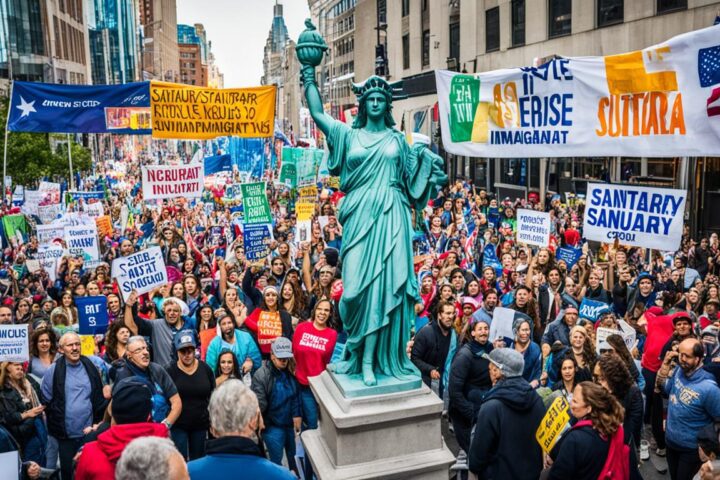Did you know over 90,000 people applied for asylum in the U.S. in 2021? The topics of asylum, refugee status, and Deferred Action for Childhood Arrivals (DACA) are complex and changing. This article aims to give you the essential information you need to understand these important immigration topics.
Key Takeaways
- Asylum and refugee status offer protection for individuals fleeing persecution in their home countries.
- DACA provides a temporary deferral of deportation and work authorization for certain undocumented immigrants who arrived in the U.S. as children.
- Eligibility requirements for asylum, refugee status, and DACA vary, and the application processes can be complex.
- Asylum seekers face challenges such as the one-year filing deadline and changes to the fear screening process.
- The 2022 Asylum Processing Rule has introduced an expedited process for some individuals entering the U.S.
Understanding Asylum and Refugee Status
Defining Asylum and Refugee Protection
Asylum and refugee status give legal protection to people who have faced or fear persecution in their home countries. Asylum seekers must be in the U.S. or at a border. Refugees apply from outside the country. Both must show they have a good reason to fear persecution because of race, religion, nationality, social group, or political beliefs. The U.S. is legally bound to protect them under international agreements.
Refugees can work in the U.S. right after getting their status and apply for a Green Card a year later. They can also join their families and travel with a Refugee Travel Document. Asylum seekers face a tough process to prove they are eligible and get legal status.
- Asylum seekers must be physically present in the U.S. or at a port of entry
- Refugees apply from outside the country and then resettle in the U.S.
- Both must demonstrate a well-founded fear of persecution on protected grounds
- The U.S. has international legal obligations to provide asylum and refugee protection
Getting refugee status or asylum in the U.S. is hard and complex. It’s important to know the differences between these two protections for those seeking safety and a new life here.
Eligibility Requirements for Asylum
To get asylum in the United States, people must show they’ve faced persecution or fear it in the future. This is because of their race, religion, nationality, social group, or political views.
Applicants must be in the US or at a border when they apply. Some actions, like serious crimes, can stop them from getting asylum. They also need to apply within a year of coming to the US, unless there are special reasons.
- The eligibility for asylum allows applicants to apply regardless of their immigration status if within 1 year of arrival to the United States.
- Exceptions for filing an application after 1 year include demonstrating changed or extraordinary circumstances affecting eligibility.
- Changed circumstances include conditions in the country of nationality and changes affecting asylum eligibility.
- Extraordinary circumstances are related to serious illness, mental or physical disability, legal disability, or loss of legal representation.
- Filing an asylum application within a reasonable time after USCIS rejects an application as not properly filed qualifies for an exception.
People who’ve been denied asylum before or are under safe country agreements might find it harder to apply. It’s important to tell about any criminal past. Not telling can lead to serious legal trouble.
DACA: Deferred Action for Childhood Arrivals
The Deferred Action for Childhood Arrivals (DACA) program offers temporary relief from deportation and work authorization. It helps certain undocumented individuals who came to the U.S. as kids. To qualify for DACA, you must meet certain age, arrival, education, and criminal history requirements.
Here are the key things you need to know about DACA eligibility:
- Being under 31 as of June 15, 2012
- Arriving in the U.S. before your 16th birthday
- Living in the U.S. since June 2007
- Having no lawful immigration status as of June 15, 2012
- Meeting education requirements, like being in school, having a high school diploma, or serving in the military
- Lacking felony convictions or posing a threat to national security or public safety
If you get DACA status, you get a two-year deferral from deportation. You can also work based on economic need. But, remember, DACA doesn’t give you lawful immigration status.
A federal court order stopped new DACA requests, but the program still helps those already with DACA. If you already have DACA, you can renew it. And, if you’ve never applied but are eligible, you can apply, but your application will be on hold for now.
To apply for DACA, you need to send Form I-821D to USCIS and provide lots of documents to prove you’re eligible. DACA offers temporary relief for undocumented immigrants who came here as kids. But, it’s not a permanent fix and doesn’t give you lawful immigration status.
The Application Process for Asylum
The United States has two main ways for people to seek asylum: affirmative asylum and defensive asylum. Affirmative asylum is for those not facing removal proceedings. Defensive asylum is for those already in court.
Affirmative and Defensive Asylum
The affirmative asylum process starts with an application to USCIS. You also go through an interview to show credible fear. If you pass, you might get asylum and stay in the U.S. forever.
Defensive asylum is in the immigration court. Here, you show reasonable fear to an immigration judge. It’s harder because you’re fighting against being deported.
There’s also the Asylum Processing Rule that mixes parts of both types for some border arrivals. It tries to make applying easier and clear up the backlog.
Every asylum path requires documents, interviews, and possibly a court hearing. Getting legal help is a smart move to understand the asylum process well.
asylum, refugee status, DACA
Asylum, refugee status, and Deferred Action for Childhood Arrivals (DACA) offer important help in the United States. They support people who are leaving their homes because of danger, violence, or other big problems.
Asylum and refugee status protect those who are being or fear being persecuted. This can be because of their race, religion, where they’re from, their political views, or their group membership. To get help, they must show they would face harm if they went back home. The asylum application process is complex and often needs legal help.
DACA gives temporary protection from deportation and work rights to some undocumented young people who came to the U.S. as kids. To qualify, they must be a certain age, have lived in the U.S. for a while, and meet education or military service requirements. Even though DACA’s future is unsure, new updates and plans help those covered by it.
Finding the right immigration help can be hard, but groups like Teach For America and the Immigrant Legal Resource Center offer great support. It’s key to know the rules and steps for asylum, refugee status, and DACA if you’re looking for protection in the U.S.
If you’re leaving danger, looking for temporary help, or want long-term solutions, check out all the immigration relief options. Learning about asylum, refugee status, and DACA helps those in need understand the U.S. immigration system better. This way, they can find the support they need.
Challenges and Barriers
Asylum seekers, refugees, and those with DACA status face many asylum challenges, refugee status challenges, and DACA challenges. These immigration barriers and systemic barriers make it hard to get through the immigration system and find important resources.
One big issue is the long wait times for asylum applications. People may wait years to have their cases heard, leaving them unsure of their future. Also, many can’t find legal help, which is key for going through the application process. The one-year deadline to file an asylum claim adds more stress, as finding all the needed documents on time is hard for some.
- Lengthy backlogs in the asylum application process
- Limited access to legal counsel for asylum seekers and refugees
- One-year filing deadline for asylum claims
- Changes to policies and procedures that create uncertainty
DACA recipients, known as Dreamers, also have a hard time getting into higher education. They face limits on federal and state aid, making it hard to pay for school. This leads to big financial worries and uncertainty about their future.
Dealing with complex application processes and gathering all the needed documents is tough for many. These systemic barriers add stress and make it harder for asylum seekers, refugees, and DACA recipients to settle into their new lives. They make it hard to reach their goals and feel part of their communities.
Asylum Processing Rule and Changes
Understanding the Asylum Processing Rule
The Asylum Processing Rule, introduced in 2022, has changed how asylum is handled in the U.S. It blends the affirmative and defensive asylum processes. The goal is to reduce the backlog and speed up the review process.
Now, people arriving at the border face expedited removal and a credible fear interview with an asylum officer. If they pass, their full case is reviewed by an asylum officer, not an immigration judge. This aims to help eligible asylum seekers faster and remove those not eligible quickly.
But, this new method has sparked worries about fair process and hearings for asylum seekers. It adds more bars to make someone ineligible for asylum, which could wrongly deny deserving claims. The higher standards and the need for asylum seekers to prove their case are big hurdles, especially for those who are marginalized or have few resources.
The Asylum Processing Rule is part of the Biden administration’s plan to fix the asylum system and clear the backlog. Yet, it has faced backlash from advocacy groups and legal experts. They say it goes against the rights of asylum seekers and U.S. laws.
Rights and Benefits
People who get asylum or refugee status in the US have special rights and benefits. They get protection from being sent back home, work authorization, and can apply for lawful permanent residency. They can also get government help. DACA recipients can work and study in the US but don’t have a direct way to become permanent residents or citizens.
For those with asylum rights, the main benefits are:
- Protection from being sent back to their home country where they fear persecution
- Work authorization to support themselves and their families
- Ability to apply for lawful permanent residency (a green card) one year after being granted asylum
- Eligibility for government assistance programs, such as Medicaid and Supplemental Security Income (SSI)
Refugee rights are similar, giving people who flee persecution the right to stay in the US. They can work and get benefits like work authorization and a path to permanent residency. DACA recipients can work and study in the US but don’t have a direct way to get immigration benefits like lawful permanent residency.
It’s important to know about these rights and benefits for those seeking asylum, refugee status, or DACA. They can greatly help in building a stable life in the United States.
Conclusion
Asylum, refugee status, and the Deferred Action for Childhood Arrivals (DACA) program are key parts of U.S. immigration policy. They offer vital protection and relief to those in danger. By learning about these programs, we can help those in need and push for better policies.
These programs are crucial for the U.S.’s commitment to human rights. They help those fleeing danger find safety. The DACA program affects over 730,000 people, giving them the right to live and work here.
As policies change, it’s important for everyone to stay updated. We must support the rights of asylum seekers, refugees, and DACA recipients. This way, we can build a fair and kind immigration system. Together, we can help those in need and make our country more diverse and vibrant.

















Maximize Profits & Get More Clients – FREE!
Stand out with a Business Credentials Report
Convert more leads with instant credibility
Rank higher on Google & increase sales
100% Free – No Credit Card Required!
Don’t lose customers to unverified competitors!
Join today at https://vettedprobusiness.my/
What if you could get business funding—without the hassle?
No credit checks, no paperwork, no sales calls. Just instant approvals and next-day funding.
See what you qualify for in 30 seconds—it’s fast, easy, and risk-free!
Don’t wait-Apply Now: http://www.nextdayworkingcapital.com/approval
Trusted by thousands of small business owners. Over 600 million funded to businesses like yours!
If you no longer wish to receive marketing messages from us, you can unsubscribe at nextdayworkingcapital.com/unsubscribe
Need Funding to Grow Your Business?
We offer tailored business loan solutions with no upfront fees—just a simple notary approval! Get the capital you need to expand, innovate, and succeed.
Email us today: info@financeworldwidehk.com
Best regards,
Laura Cha
Customer Service Representative
Looking for working capital? See what you qualify for in 30 seconds—no credit check, no paperwork, no sales calls.
Instant approvals, next-day funding. It’s fast, free, and fully automated.
Get started now: http://www.nextdayworkingcapital.com/approval
Trusted by thousands of small business owners. Over 600 million funded to businesses like yours!
If you no longer wish to receive marketing messages from us, you can unsubscribe at https://nextdayworkingcapital.com/unsubscribe